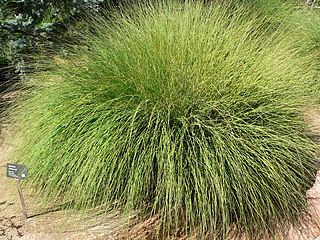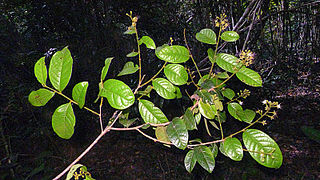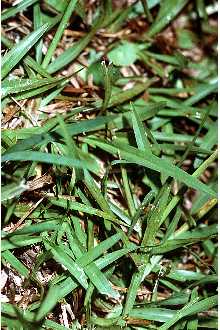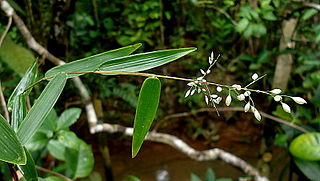Related Research Articles

Cortaderia is a genus of South American and Central American plants in the Poaceae grass family.

Guadua is a Neotropical genus of thorny, clumping bamboo in the grass family, ranging from moderate to very large species.

Pouteria is a genus of flowering trees in the gutta-percha family, Sapotaceae. The genus is widespread throughout the tropical Americas, with outlier species in Cameroon and Malesia. It includes the canistel, the mamey sapote, and the lucuma. Commonly, this genus is known as pouteria trees, or in some cases, eggfruits.

Eschweilera is a genus of woody plants in the family Lecythidaceae first described as a genus in 1828. It is native to southern Mexico, Central America, South America, and Trinidad.

Muhlenbergia is a genus of plants in the grass family.

Aegiphila is a genus of flowering plants in the mint family, Lamiaceae, first described in 1763. It was formerly classified in the Verbenaceae. It is native to Mexico, Central America, South America, the West Indies, and Florida.

Hirtella is a genus of 110 species of woody trees in family Chrysobalanaceae. It was first described as a genus by Linnaeus in 1753. Hirtella naturally occurs in tropical forests throughout Latin America, the West Indies, southeast Africa, and Madagascar. The flowers are mainly pollinated by butterflies.

Axonopus is a genus of plants in the grass family, known generally as carpet grass. They are native primarily to the tropical and subtropical regions of the Americas with one species in tropical Africa and another on Easter Island. They are sometimes rhizomatous and many are tolerant of periodic submersion.

Piresia is a genus of South American plants in the grass family.
- Piresia goeldiiSwallen - French Guiana, Suriname, Venezuela (Amazonas), Colombia (Amazonas), Ecuador, Peru (Loreto), Brazil
- Piresia leptophyllaSoderstr. - Colombia (Amazonas), Ecuador, Peru, Brazil(Pernambuco, Amazonas, Bahia), Trinidad & Tobago
- Piresia macrophyllaSoderstr. - French Guiana, Peru, Brazil
- Piresia palmulaM.L.S.Carvalho & R.P.Oliveira - Brazil (Bahia)
- Piresia sympodica(Döll) Swallen - Venezuela, French Guiana, Suriname, Guyana, Colombia, Ecuador, Peru, Brazil, Trinidad & Tobago
Raddiella is a genus of Neotropical plants in the grass family native to South America, Panama and Trinidad.
- Raddiella esenbeckii(Steud.) C.E.Calderón ex Soderstr. - Brazil, Bolivia, Colombia, Venezuela, French Guiana, Suriname, Guyana, Trinidad, Panama
- Raddiella kaieteuranaSoderstr. - Venezuela (Bolívar), Suriname, Guyana, Brazil (Pará)
- Raddiella lunataZuloaga & Judz. - Rondônia, Mato Grosso
- Raddiella malmeana(Ekman) Swallen - Pará, Mato Grosso
- Raddiella minimaJudz. & Zuloaga - Pará, Mato Grosso
- Raddiella molliculma(Swallen) C.E.Calderón ex Soderstr. - Caquetá
- Raddiella potaroensisSoderstr. - Venezuela (Bolívar), Guyana
- Raddiella vanessiaeJudz. - French Guiana

Luziola (watergrass) is a genus of New World in the grass family, native to North and South America including the West Indies.
Streptostachys is a genus of South American plants in the grass family.

Olyra is a genus of tropical bamboos in the grass family. It is native primarily to the Western Hemisphere, with one species extending into Africa.
Otachyrium is a genus of South American plants in the grass family.

Parodiolyra is a genus of Neotropical plants in the grass family.
- Parodiolyra aratitiyopensisJ.R.Grande - Venezuela (Amazonas)
- Parodiolyra colombiensisDavidse & Zuloaga - Colombia (Caquetá)
- Parodiolyra lateralis(J.Presl ex Nees) Soderstr. & Zuloaga - Nicaragua, Costa Rica, Panama, Colombia, Venezuela, Guyana, Suriname, Ecuador, Peru, Brazil
- Parodiolyra luetzelburgii(Pilg.) Soderstr. & Zuloaga - Brazil, Colombia, Venezuela, Guyana, Suriname, French Guiana
- Parodiolyra micrantha(Kunth) Davidse & Zuloaga - Brazil, Colombia, Venezuela, Guyana, Suriname, French Guiana, Peru, Bolivia, Argentina, Paraguay
- Parodiolyra ramosissima(Trin.) Soderstr. & Zuloaga - Brazil (Bahia)

Homolepis is a genus of Neotropical plants in the grass family. They are native to Mexico, Central and South America, and the West Indies.

Nymphidium is a genus in the butterfly family Riodinidae present only in the Neotropical realm.

Calospila is a butterfly genus in the family Riodinidae. They are resident in the Americas.
References
- ↑ Tropicos, Thrasya Kunth
- ↑ Kunth, Karl Sigismund. 1816. Nova Genera et Species Plantarum (quarto ed.) 1: 120–121 in Latin
- ↑ Kunth, Karl Sigismund. 1816. Nova Genera et Species Plantarum (quarto ed.) 1: plate XXXIX (39) line drawing of Thrasya paspaloides
- ↑ Grassbase - The World Online Grass Flora
- ↑ Burman, A. G. 1985 [1987]. The genus Thrasya H.B.K. (Gramineae). Acta Botanica Venezuelica 14(4): 7–93
- ↑ The Plant List search for Thrasya
- ↑ Zuloaga, F. O. & O. Morrone. 2003. Thrasya. In Catalogue of New World Grasses (Poaceae): III. Subfamilies Panicoideae, Aristidoideae, Arundinoideae, and Danthonioideae. Contributions from the United States National Herbarium 46: 613–616
- ↑ Nelson, C. H. 1978. Contribuciones a la flora de la Mosquitía, Honduras. Ceiba 22(1): 41–64.